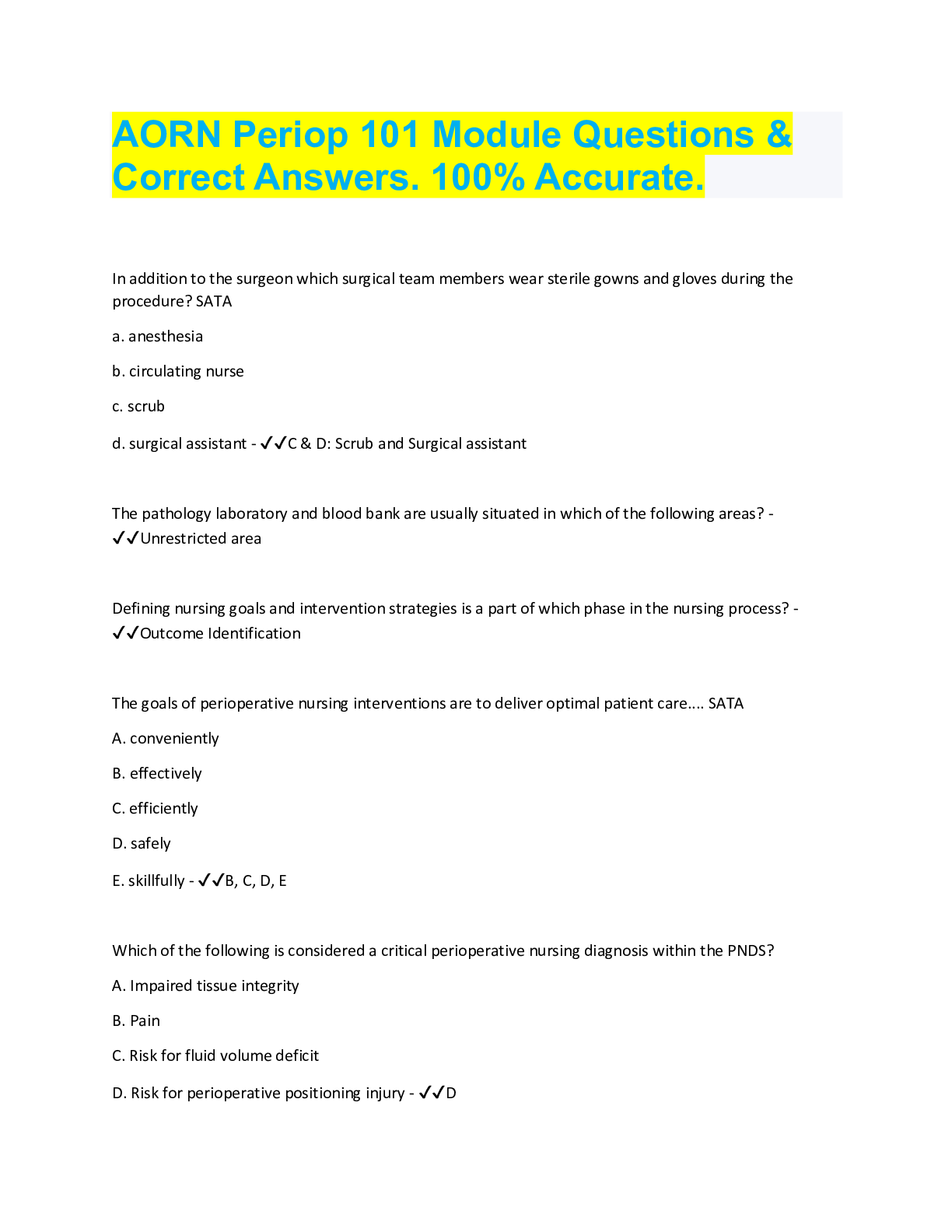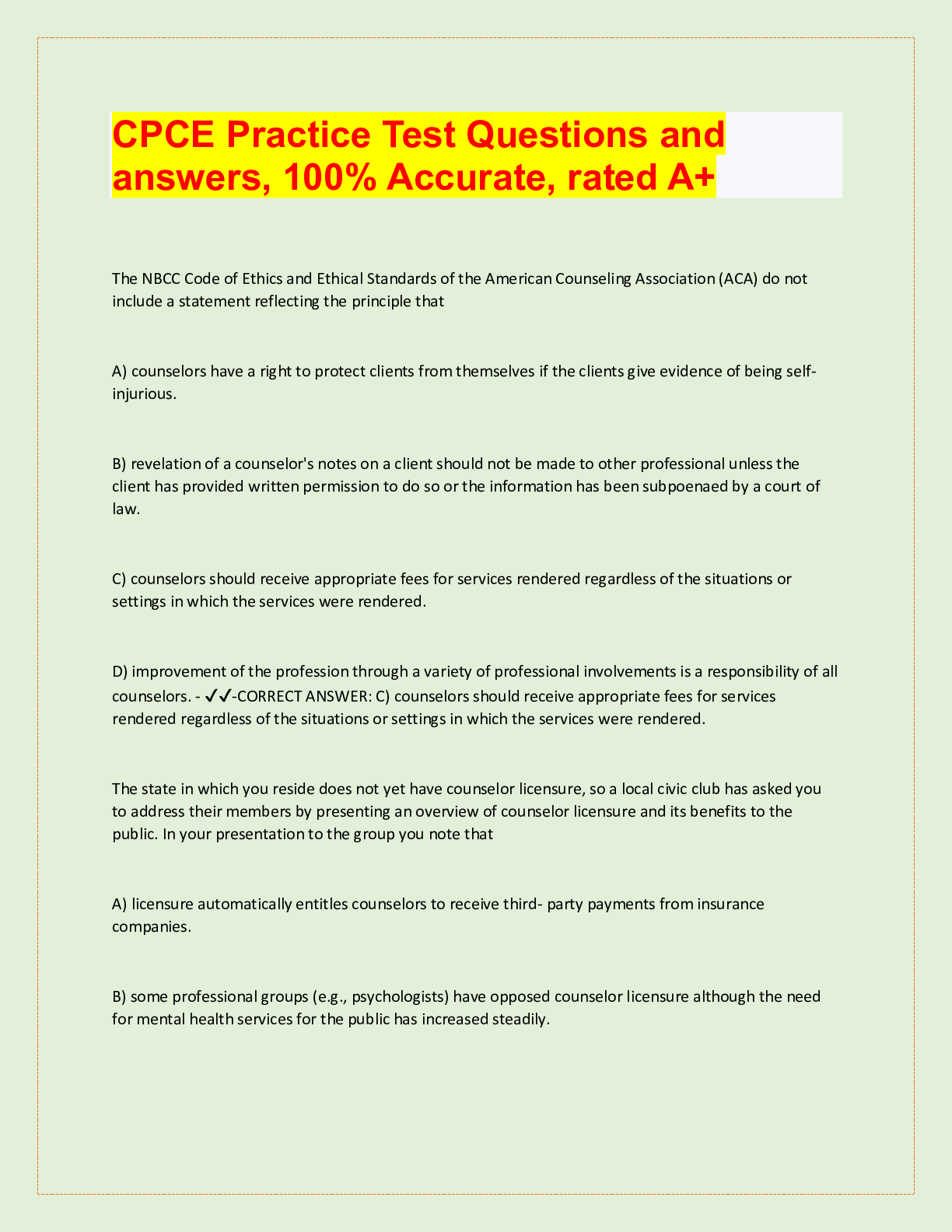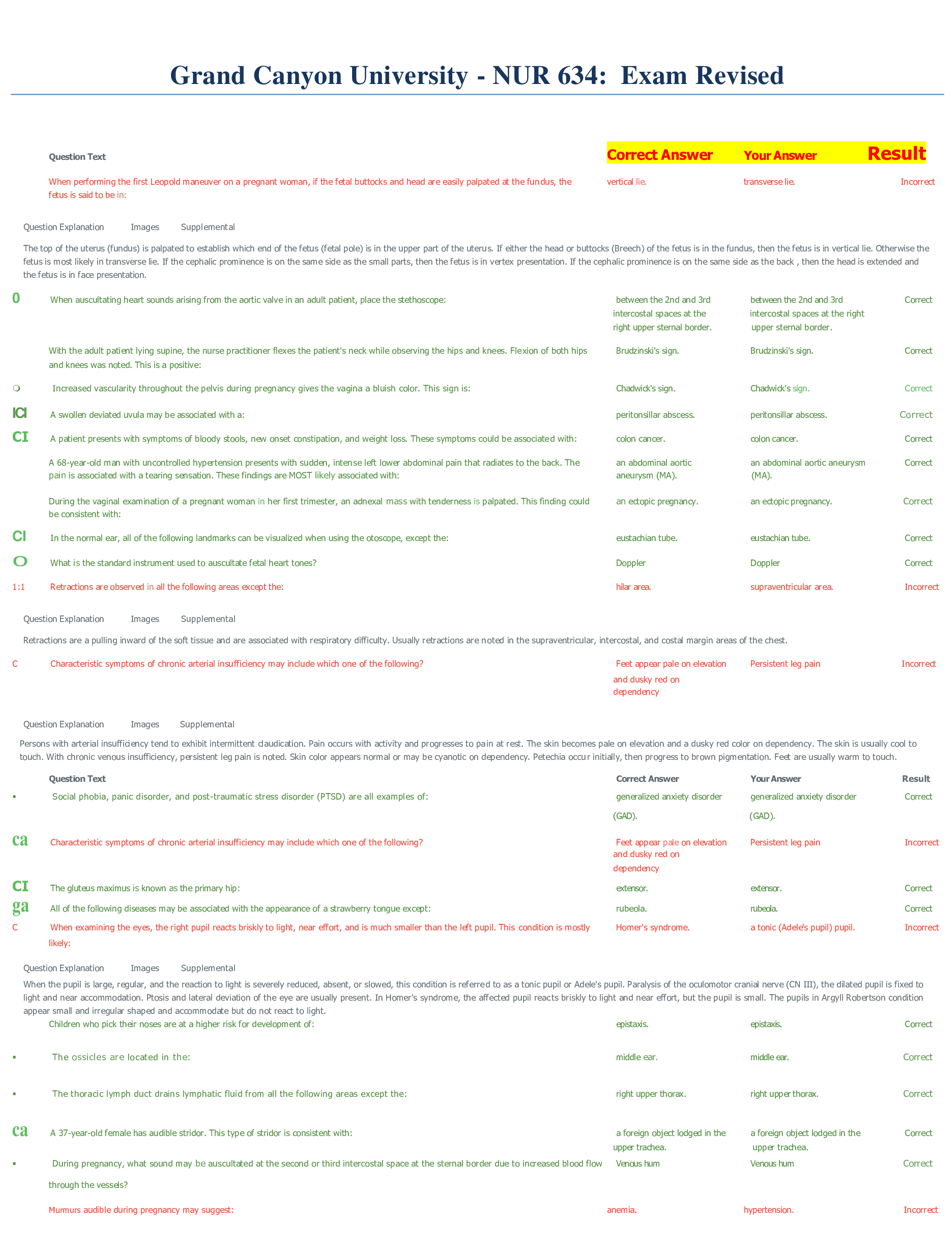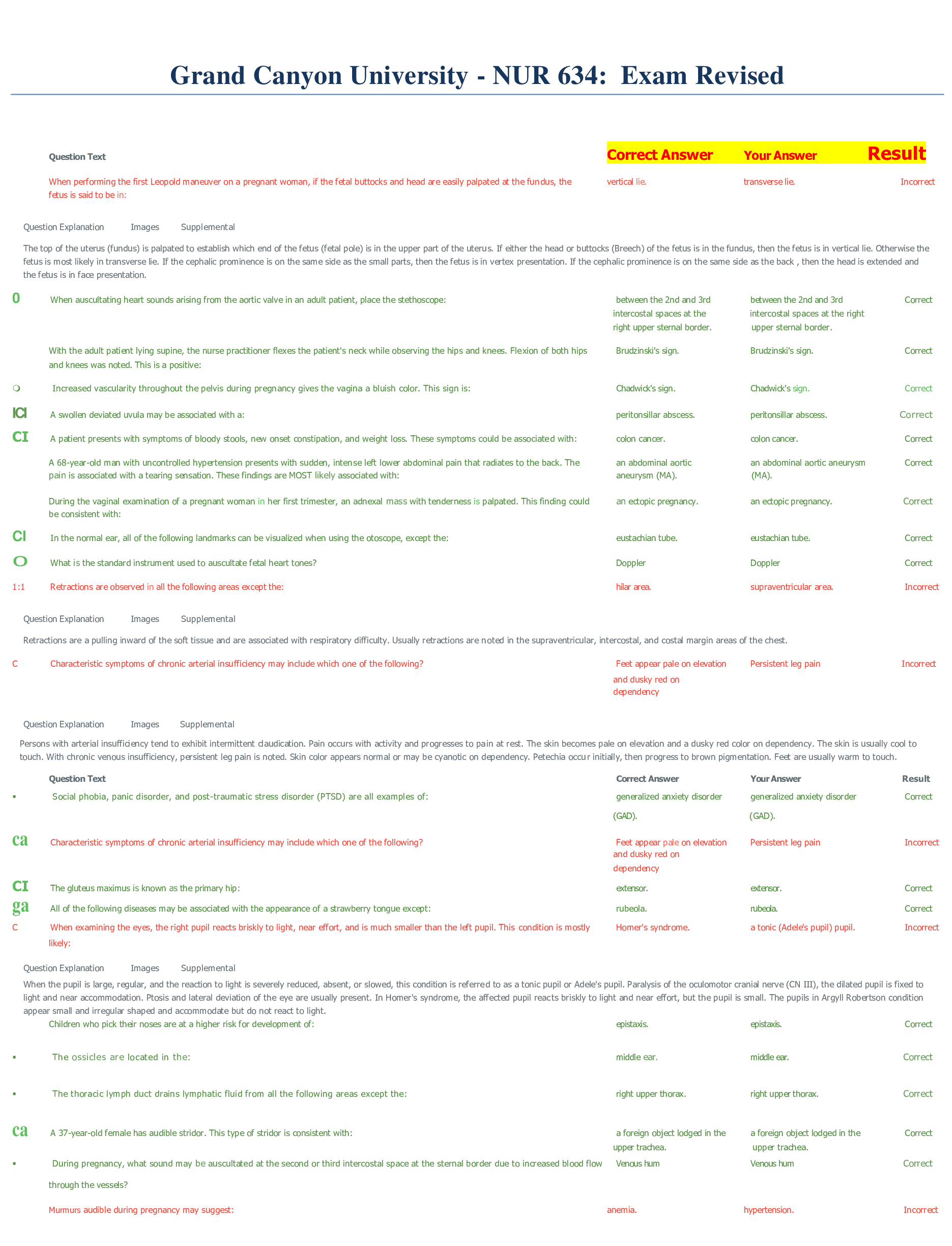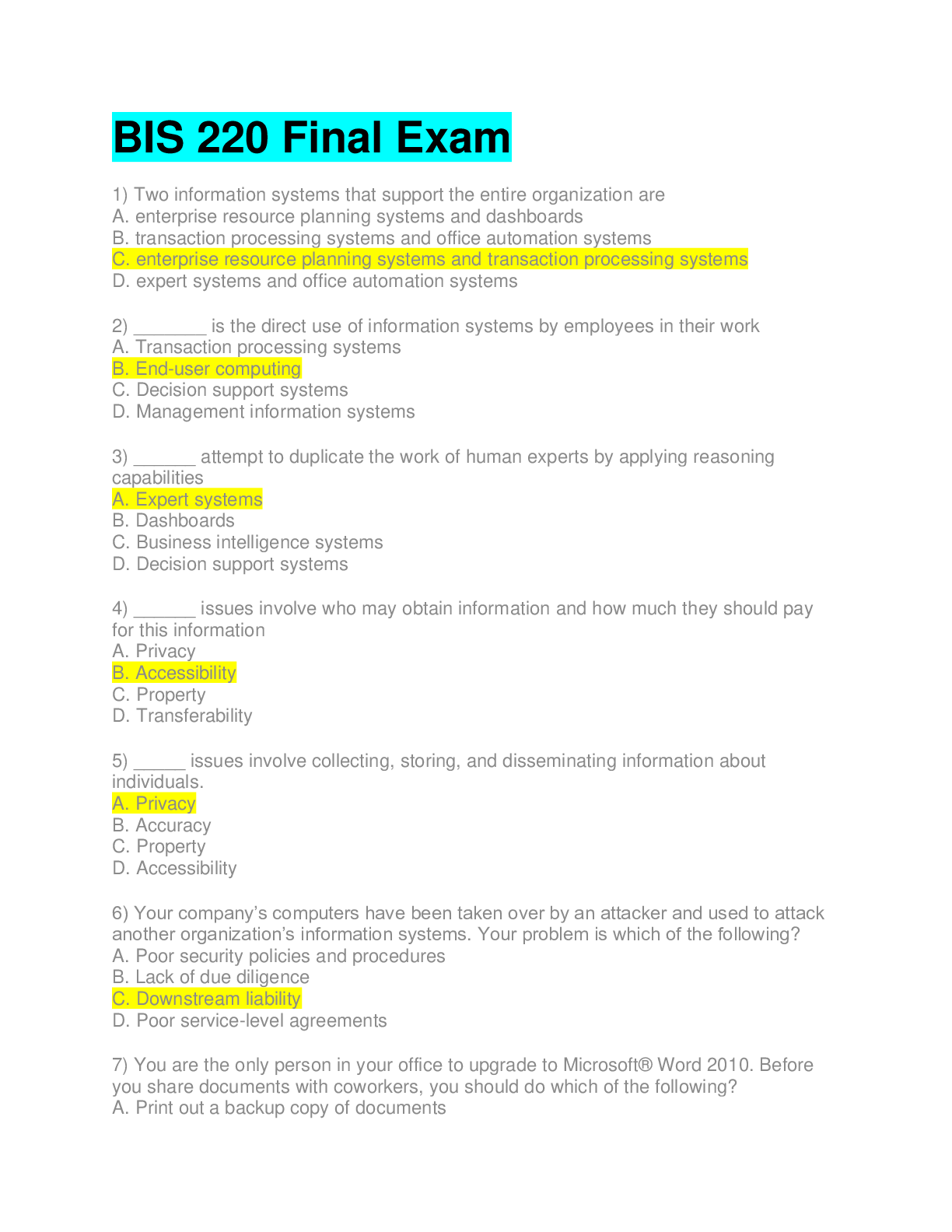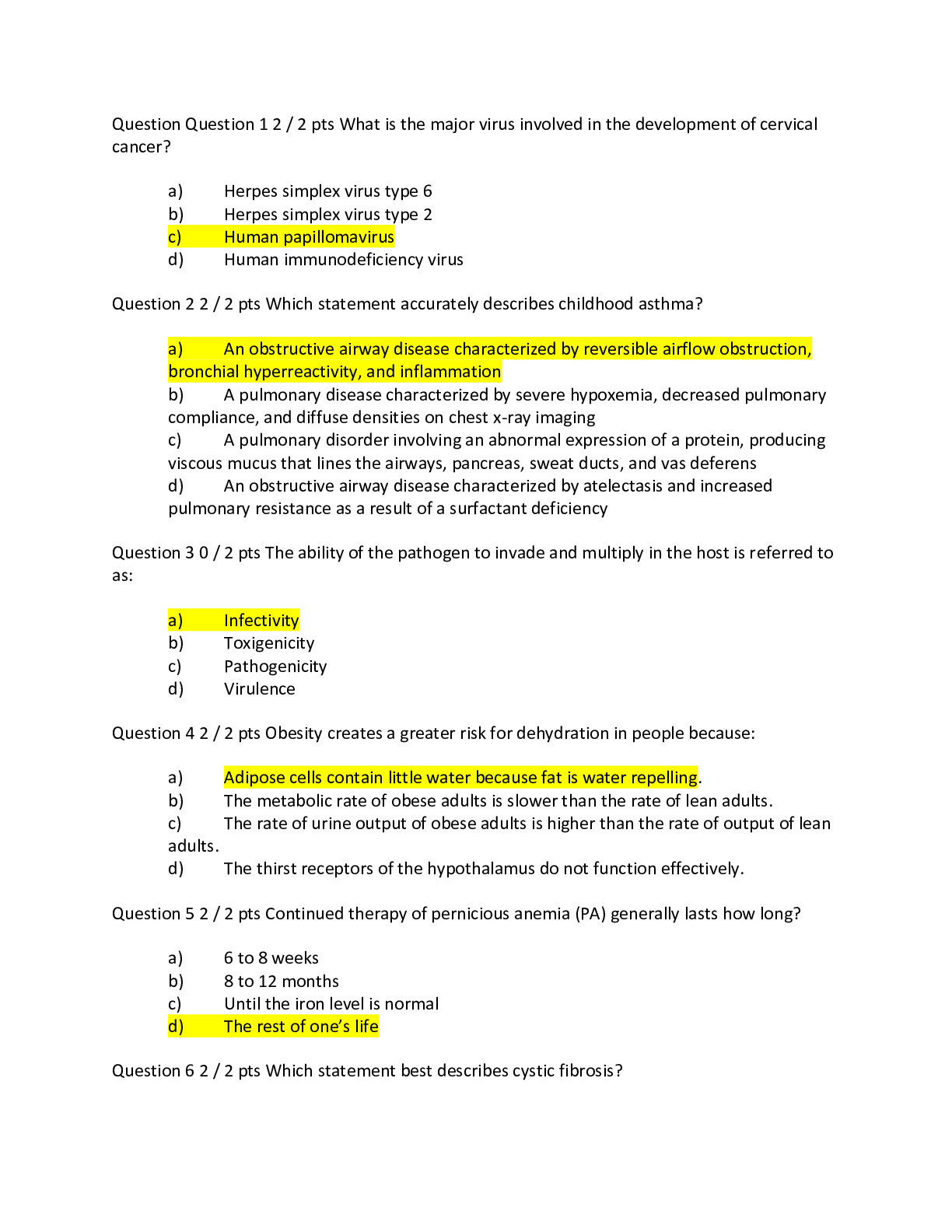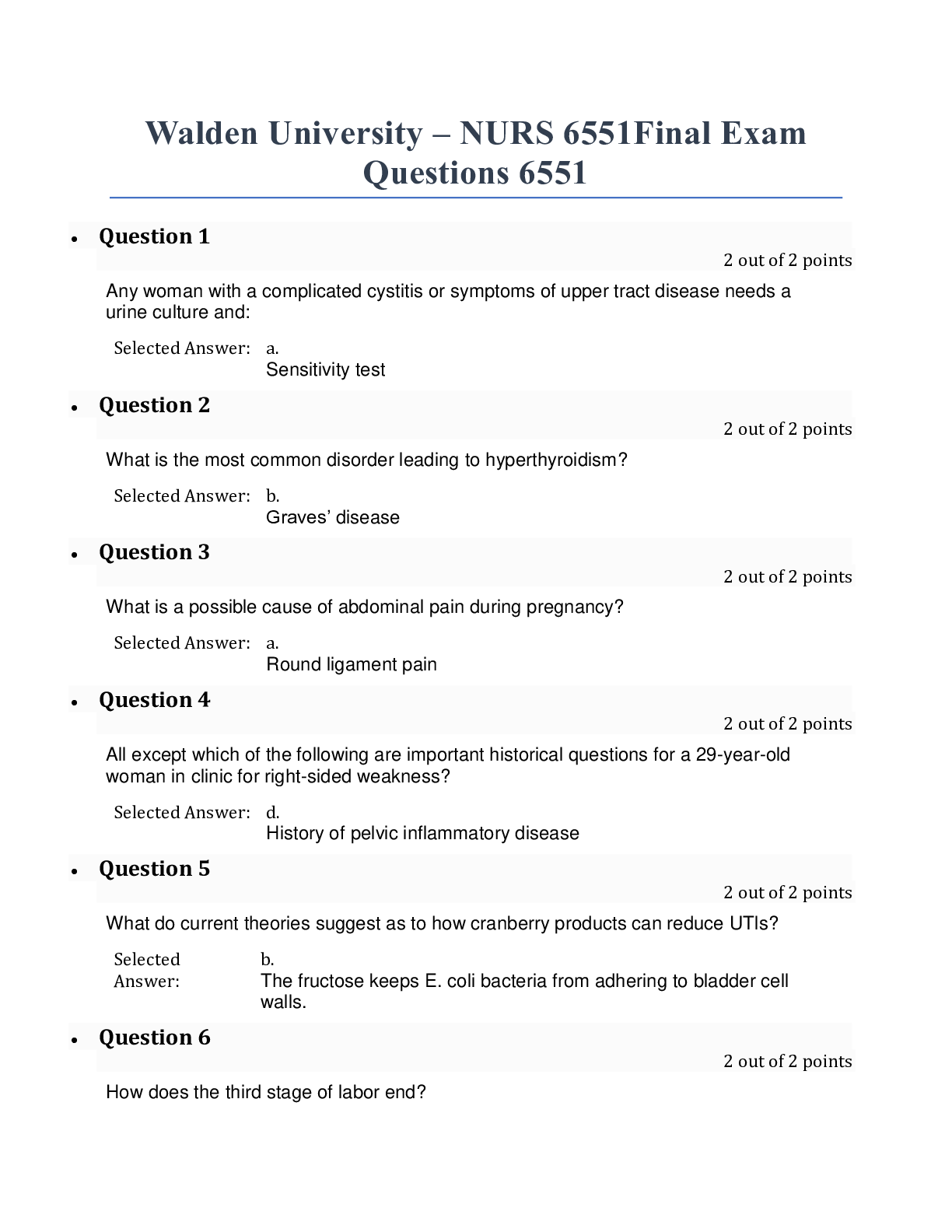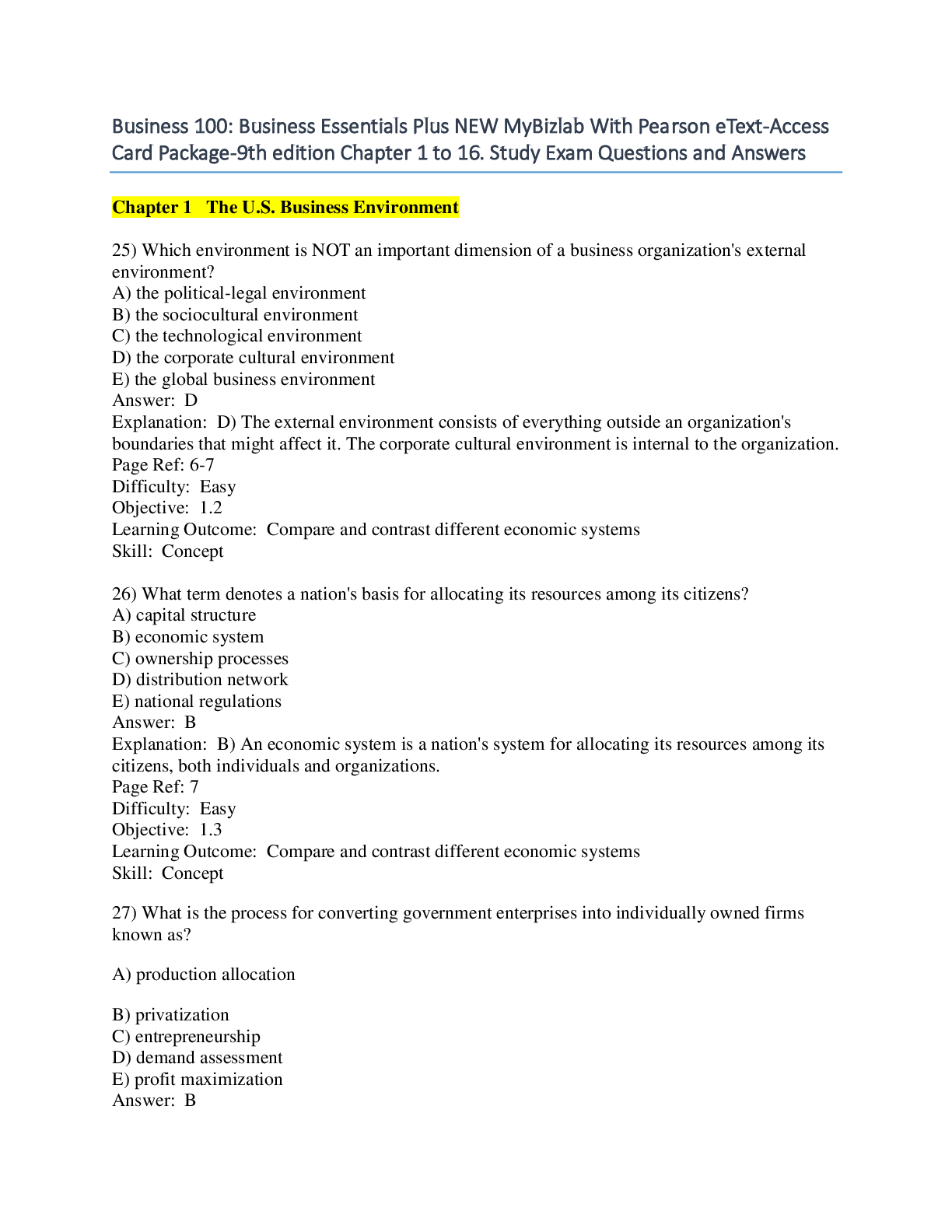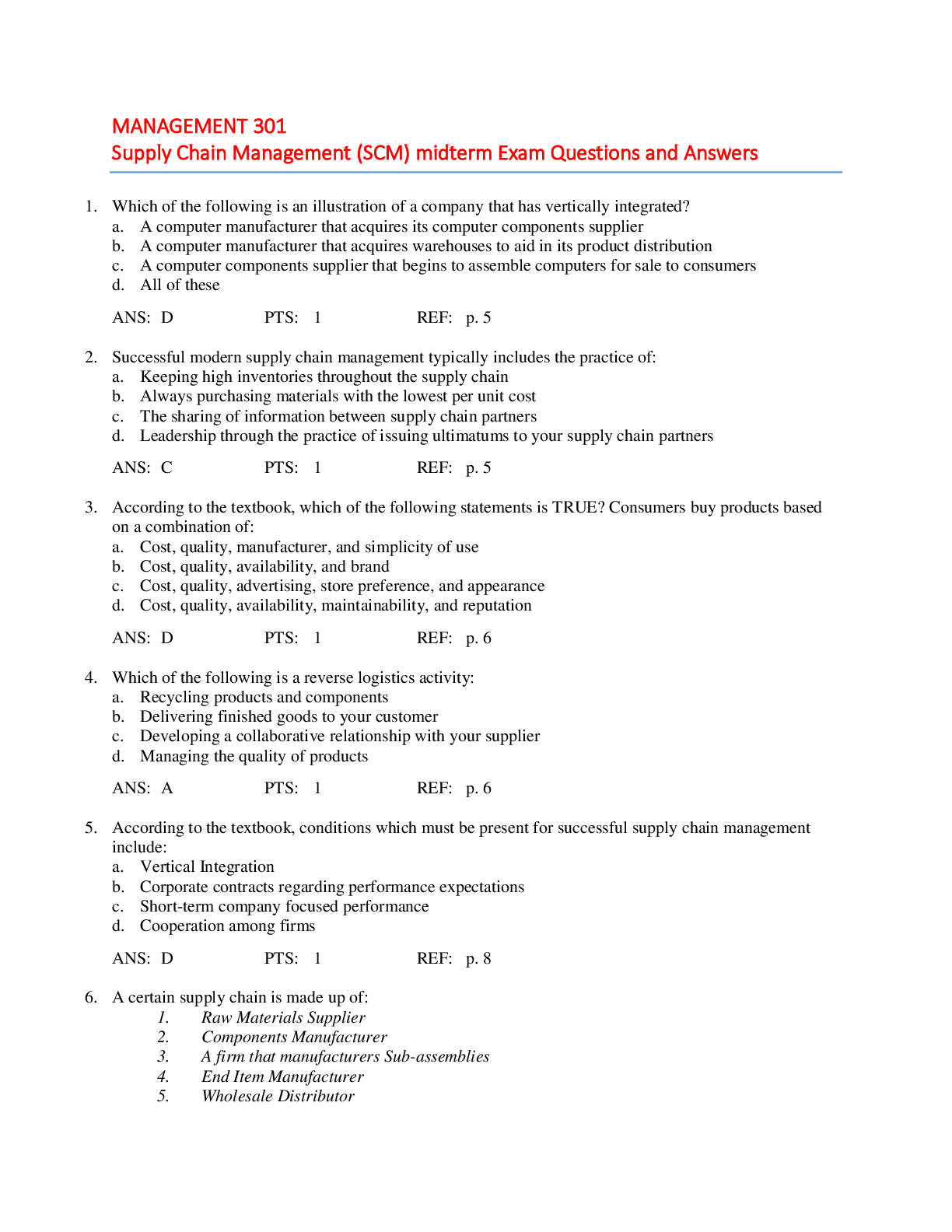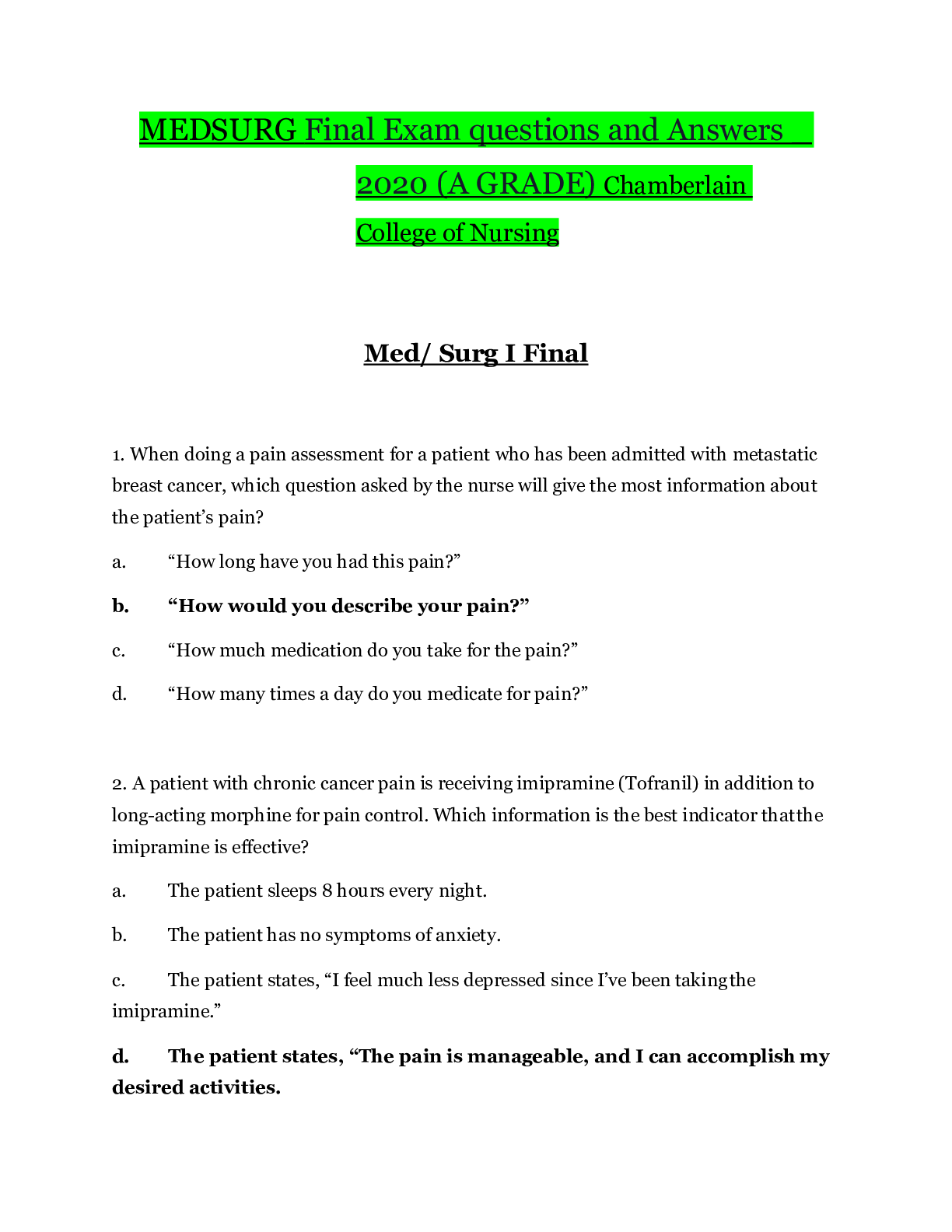BioChemistry > QUESTIONS & ANSWERS > Readiness Check WGU C785 Biochem SCG. Top Exam Questions and answers, rated A+, Verified. (All)
Readiness Check WGU C785 Biochem SCG. Top Exam Questions and answers, rated A+, Verified.
Document Content and Description Below
Readiness Check WGU C785 Biochem SCG. Top Exam Questions and answers, rated A+, Verified. Choose the correct coding strand (non-template) from this template (non-coding) DNA: 5' ATC GAT 3' 3' ... TAG CTA 5' If one strand of chromosome 2 has a DNA sequence that consists of this: 5’ AGA CTA ATT GCC 3’, what will be the composition of the complementary DNA strand? (Select all that apply) 3' TCT GAT TAA CGG 5' 5' GGC AAT TAG TCT 3' 00:0201:36 The following sequence is the coding strand of the collagen gene: 5’ GGC AAA TAT CGA 3’ What is the sequence of the corresponding mRNA?5' GGC AAA UAU CGA 3' 5' GGC AAA UAU CGA 3' Which of the following are the correct components for a PCR reaction? dNTPs, Primer, DNA Polymerase, template DNA Which of the following steps in PCR occurs first? Denaturation Annealing Cycling Elongation Denaturation Which statement accurately describes how a frameshift mutation affects a gene? a. It will change a single nucleotide in a mutant gene compared to the normal gene. Examples are missense, nonsense, and silent mutations. b. It will change the number of nucleotides in a mutant gene compared to the normal gene. Examples are missense, nonsense, and silent mutations. c. It will change the number of nucleotides in a mutant gene compared to the normal gene. Examples are insertion and deletion mutations. d. It will change a single nucleotide in a mutant gene compared to the normal gene. Examples are insertion and deletion mutations c. It will change the number of nucleotides in a mutant gene compared to the normal gene. Examples are insertion and deletion mutations. After skiing during a winter vacation and getting a mild facial tan, a patient had an untimely herpes flare-up on his upper lip. Herpes Simplex Type I, is the most common cause of cold sores. HSV-1 is a DNA retrovirus that embeds itself into the host genome, as long as the HSV-1 genes are expressed the symptoms will persist. What caused the herpes flare-up? a. the HSV-1 genes became open and available as the result of repairing UV damage, decreasing HSV-1 expression b. the HSV-1 genes became closed and hidden as the result of repairing UV damage, increasing HSV-1 expression c. the HSV-1 genes became closed and hidden as the result of repairing UV damage, decreasing HSV-1 expression d. the HSV-1 genes became open and available as the result of repairing UV damage, increasing HSV-1 expression d. the HSV-1 genes became open and available as the result of repairing UV damage, increasing HSV-1 expression Which of the following describes an epigenetic change? a. Denaturation of template DNA to facilitate primer annealing. b. Increased methylation of the promoter region of a tumor suppressor gene in a developing fetus. c. Thymine dimer formation resulting from UV radiation. d. Mismatch mutation caused by mistakes made by DNA Polymerase during replication. b. Increased methylation of the promoter region of a tumor suppressor gene in a developing fetus. What is the correct definition of nucleotide excision repair? a. Damage to a few or several nucleotides are identified, then many nucleotides are removed and all are replaced to repair the DNA segment b. Removal of a single damaged nucleotide c. Required when there are breaks in the double stranded DNA strand which causes discontinuity in both strands d. Insertion of a thymine dimer a. Damage to a few or several nucleotides are identified, then many nucleotides are removed and all are replaced to repair the DNA segment Several components of cigarette smoke, including benzopyrene, insert themselves (intercalate) into the DNA and lead to several types of mutations such as frameshift mutations, including both insertions and deletion. Which of the following repair pathways would be used to repair this type of damage? a. Nucleotide Excision Repair b. Base excision repair c. Homologous Recombination d. Mismatch Repair a. Nucleotide Excision Repair Which of the following forces can lead to aggregation as a result of protein misfolding? a. hydrogen bonds b. disulfide bonds c. hydrophobic interactions d. ionic bonds c. hydrophobic interactions Primary structure consists of the order of ______ in a protein. These are held together with ______ bonds that are formed by a ______ reaction. a. Nucleotides, phosphodiester, dehydration b. Amino acids, peptide, hydrolysis c. Amino acids, peptide, dehydration d. Nucleotides, peptide, dehydration c. Amino acids, peptide, dehydration Myoglobin is an oxygen storage protein and exhibits a hyperbolic curve in an oxygen saturation graph. What is the highest level of protein structure exhibited by myoglobin? a. Primary b. Secondary c. Tertiary d. Quaternary c. Tertiary What type of reaction breaks peptide bonds apart? a. Methylation Reaction b. Oxidation/Reduction Reaction c. Hydrolysis Reaction d. Condensation Reaction c. Hydrolysis Reaction An elderly patient is diagnosed with Alzheimer’s Disease. Which of the following is most likely the cause of this neurological disorder? a. Disulfide bond formation by cysteine amino acids b. Iron deficiency c. Aggregation of hydrophobic amino acids d. Ionic bonds formed by hydrogen bonding of amino acids c. Aggregation of hydrophobic amino acids A patient presents with a fever of 110°F. Which interaction(s) would be disrupted within a neuronal protein if the fever is not resolved quickly? a. Disulfide Bond b. Hydrogen Bond c. Ionic Bonds d. Hydrophobic Interactions d. Hydrophobic Interactions A diabetic patient is suffering from ketoacidosis. Which interaction(s) could be disrupted within the patientʼs hemoglobin due to this condition. Select all that apply. Hydrogen Bond Ionic Bonds Hydrophobic Interactions Disulfide bond Hydrogen Bond Ionic Bonds Chymotrypsin is a digestive enzyme that has optimal activity at a pH of 7.8 and a temperature of 37 degrees Celsius. Which of the following statements is true? a. At a temperature of 100 degrees Celsius, chymotrypsin will have slight activity. b. At a pH of 8.5, chymotrypsin will have increased activity compared to chymotrypsin at a pH of 7.8. c. At a pH of 8.5, chymotrypsin will have decreased activity compared to chymotrypsin at a pH of 7.8. d. At a temperature of 20 degrees Celsius, chymotrypsin will demonstrate increased activity compared to a reaction at 37 degrees C. c. At a pH of 8.5, chymotrypsin will have decreased activity compared to chymotrypsin at a pH of 7.8. Which of the following forces can lead to aggregation as a result of protein misfolding? a. hydrogen bonds b. ionic bonds c. disulfide bonds d. hydrophobic interactions d. hydrophobic interactions Which of the following are true about a misfolded protein? Select all that apply. It can cause protein aggregation. It loses its primary structure. It can be degraded by the cell. It will lose its normal function. It can be the result of denaturation. 29 It can cause protein aggregation. It can be degraded by the cell. It will lose its normal function. It can be the result of denaturation. Which of the following statements correctly describes the difference between hemoglobin and myoglobin? a. Hemoglobin binds oxygen in a cooperative manner, while Myoglobin binds oxygen with a relatively higher affinity and stores oxygen. b. Hemoglobin has tertiary structure, while Myoglobin has quaternary structure and binds oxygen in a cooperative manner. c. Hemoglobin stores oxygen and Myoglobin delivers oxygen to oxygen-deprived muscle tissue. d. Myoglobin is bound by 2,3-BPG and changes into the T-state to deliver oxygen a. Hemoglobin binds oxygen in a cooperative manner, while Myoglobin binds oxygen with a relatively higher affinity and stores oxygen. Which of the following statements accurately describes cooperativity? a. Oxygen and carbon dioxide exchange occurs in the alveoli of the lungs. b. Hemoglobin can bind subsequent molecules of oxygen more easily after the first oxygen molecule binds. c. Myoglobin and hemoglobin work together to deliver oxygen to the tissues. d. Myoglobin can bind subsequent molecules of oxygen more easily after the first oxygen molecule binds. b. Hemoglobin can bind subsequent molecules of oxygen more easily after the first oxygen molecule binds. Carbon monoxide is poisonous because the ability of carbon monoxide to bind to hemoglobin is ___________ than the ability of oxygen to bind to hemog [Show More]
Last updated: 1 year ago
Preview 1 out of 16 pages
Instant download

Buy this document to get the full access instantly
Instant Download Access after purchase
Add to cartInstant download
Reviews( 0 )
Document information
Connected school, study & course
About the document
Uploaded On
Mar 10, 2023
Number of pages
16
Written in
Additional information
This document has been written for:
Uploaded
Mar 10, 2023
Downloads
0
Views
63






